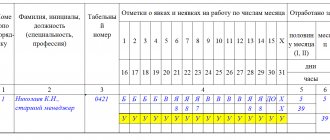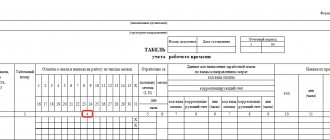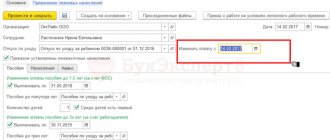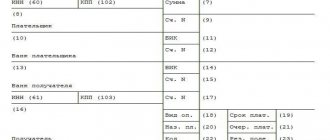Rate this post
One of the main responsibilities of the employer is maintaining a time sheet (Article 91 of the Labor Code of the Russian Federation).
It displays:
- working days and weekends;
- number of hours worked;
- various deviations from the schedule (for example, vacations and business trips).
Based on the timesheet, wages are calculated. An accounting form is maintained for each employee from the first working day until the day of dismissal.
Legend
A timesheet is a table with columns and columns indicating the full name, position, and department of the employee. The actual time worked and the time of absence are reflected, whether it is a day off or absenteeism.
Work and rest time is depicted in the form of codes - alphabetic or numeric symbols.
The codes indicate the following parameters:
- showing up for work;
- absenteeism;
- vacation;
- weekend;
- other variables, an exhaustive list of which is indicated on the first sheet of form T-12.
The most commonly used designations include the following:
- work during the daytime - I or 01 (the letter designation is in the first place, the digital designation is in the second place, similar below);
- business trip - K or 06;
- annual leave - FROM or 09;
- additional leave - OD or 10;
- maternity leave - P or 14;
- leave without pay - up to or 16;
- temporary disability - B or 19;
- weekends and non-working holidays - B or 26.
FAQ
Question one: How long must timesheets be kept at the company or in the archive?
The document is considered the first accounting form, which is used for calculating salaries and must be kept for five years. If the organization uses work in dangerous or harmful conditions, accounting for the time of use of duties is important for the urgent provision of a pension. Then the documents are retained for seven ten-five years.
Question two: Can adjustments be allowed if the information has changed? For example, a document was handed in, but the employee provided new information?
Crossing out or erasing previously entered information on the report card is not recommended and is not allowed. If there is a need to change the information, the person responsible for accounting is obliged to present a correction sheet to the submitted document and indicate the clarification number. An official document (note) is drawn up about the need for adjustment and the reasons.
Question three: Is it necessary to reflect partial hours worked by an employee?
If the duration of working time is one whole hour, then the minutes can be omitted, only the number of hours can be entered, for example, 5 or 7. But if the length of the working day was hours and minutes, it is necessary to specify both full and partial working hours. In the report card, a work day with a duration of 7 hours 15 minutes in the report card can be o. Often managers, by shortening the lunch break, reduce the duration of work on Friday. Then in this case, you need to put “7.15” on the timesheet from Mon to Thu and “6” on Fri.
How is dismissal indicated on the report card?
Dismissal at your own request
Let's look at the most standard option - voluntary dismissal.
As a general rule, the day of dismissal is considered to be the employee’s last working day (Article 84.1 of the Labor Code). On the last working day of the employee, you need to indicate attendance (I), which will also be the day of dismissal.
An exception is when the employee did not work, but his place of work was retained.
IMPORTANT. All employment relationships terminate on this day; the employee works this day in full. For example, if work is until 17.00, then just at 17.00 the documents are reviewed, signed by the employee, payment is made, and the work book and other documents are issued.
Dismissal during vacation
The last day of vacation and the day of dismissal coincide. The leave mark is placed on the time sheet - O (or another mark depending on the type of leave). This same day is considered the day of dismissal.
Career
Data on the working time of each employee is needed to correctly calculate his average earnings. Therefore, the employer is obliged to keep records of working hours, regardless of the remuneration system used.
The employer is obliged to keep records of the time actually worked by each employee (Article 91 of the Labor Code of the Russian Federation).
| The article is published within the framework of cooperation between HRMaximum and the journal “Actual Accounting”. |
The organization has the right to either keep records in a form developed independently and approved by the head of the organization, or, as before, use a unified form (approved by the post of the State Statistics Committee of Russia dated January 5, 2004 N 1). At the same time, in our opinion, the second option is simpler and more convenient. The unified form contains all the lines and columns necessary for the correct organization of accounting. Let's take a closer look at the order of filling it out.
| Figure 1. |
| Fig.2 |
| Fig.3 |
| Fig.4 |
| Fig.5 |
Timesheet form N T-12 (Fig. 1) is used for manual accounting, N T-13 (Fig. 2) for automated accounting. Note that Form N T-12 consists of two sections: I - “Accounting for working hours” (continued in Fig. 1) and II - “Settlements with personnel for wages” (continued in Fig. 1). The first section is intended directly to record the time worked by employees, the second - to reflect the calculation of their wages. In this case, the organization has the right to keep separate records of these data. In such a situation, section II of the report card is not filled out.
Both timesheets are drawn up in one copy. In this case, working time is taken into account in the timesheet in one of two ways: either by the method of continuous registration of appearances and absences from work, or by the method of recording only deviations (no-shows, lateness, overtime, etc.). When reflecting absences from work, which are recorded in days (vacation, days of temporary disability, business trips, leave in connection with training, time spent performing government duties, etc.), only symbol codes are entered in the top line of the timesheet in the columns , and the columns in the bottom line remain empty.
On the title page of time sheet N T-12 there are symbols of worked and unworked time. They should also be used when filling out the timesheet in form N T-13 (continuation of Fig. 1).
In most cases, the timesheet is submitted to the accounting department once a month upon completion. However, this is not entirely true. The fact is that wages must be paid to the employee at least every half month (advance payment and final payment) (Article 136 of the Labor Code of the Russian Federation). In this case, the advance is calculated based on the time actually worked by the employee, which is reflected in the time sheet. It turns out that for temporary employees, time sheets need to be issued every six months. Otherwise, the accounting department will not be able to correctly charge them an advance.
Maintaining timesheets is the responsibility of the organization. Moreover, it is necessary even if the organization uses a piece-rate form of remuneration. On the one hand, when using this system, an employee’s earnings do not depend on the amount of time he works. It is determined based on the established prices for the volume of work performed in physical quantities. However, regardless of the remuneration system established in the organization, the duration of working hours is limited by labor legislation. Therefore, the employer is obliged to keep records of it. The Labor Code does not make any exceptions to this rule (Article 91 of the Labor Code of the Russian Federation). In addition, data on the working time spent by each employee of the organization is needed to correctly calculate his average earnings and generate statistical reporting.
When dismissing an employee, the organization, at his request, must issue an extract from the time sheet. According to labor legislation, the employer is obliged, on the day of termination of the employment contract, to issue the employee a work book and certified copies of other documents related to his work (Article 84.1 of the Labor Code of the Russian Federation).
They are presented at the request of the employee. Moreover, the Labor Code does not establish a list of these documents. The timesheet is directly related to the employee’s work. Therefore, he has the right to demand a copy of it.
However, the report card contains data not only on the person leaving, but also on other employees. Moreover, the information contained in the report card is their personal data. Therefore, they can only be transferred to other persons with their consent. Thus, in this situation, in order not to obtain the consent of other employees, the organization has the right to draw up an extract from the document in question, which will indicate information only about the resigning employee.
Features of filling out timesheets in certain situations
The legislation does not clearly regulate the procedure for filling out a unified report form in various situations that deviate from normal ones. Therefore, an accountant or timekeeper has to independently decide what to show in the timesheet in each particular case.
To record working hours, an organization can either develop its own time sheet form or maintain it in a unified form. At the same time, when developing her own form, she has the right to take the unified form as a basis, supplement it with any details and delete unnecessary data. The main thing is that this form is subsequently approved by the head of the organization.
Working overtime
Let's assume that the timesheet is filled out using the method of continuous registration of attendances and absences. An employee of the organization worked overtime (10 hours instead of the established 8). Which code should be entered on the report card for this day: “I” (duration of work during the daytime) or “C” (duration of overtime work)?
In this case, an additional column can be entered into the timesheet. In the existing column put the code “I”, in the additional one - “C”. At the same time, for the convenience of further calculations, it is advisable to separate the normal and overtime hours and indicate them in the appropriate columns.
At the same time, such a problem will not arise if only deviations from the normal working hours are recorded in the timesheet.
Work on a business trip day
An employee, by agreement with the employer, can go to work on the day he returns from a business trip. It turns out that, on the one hand, his business trip has not ended (timesheet code “K”), on the other hand, he is already at his workplace (timesheet code “I”). Please note that the issue of an employee’s attendance at work on the day of departure on a business trip and on the day of arrival from a business trip is resolved by agreement with the employer. This is provided for by the Regulations on the specifics of sending employees on business trips (approved by the resolution of the Government of the Russian Federation of October 13, 2008 N 749).
The employee is not required to go to the workplace on the day of the business trip. However, by agreement with the employer, he can do this either full-time or part-time. In this case, the organization is obliged to pay him:
— the day of the business trip (the day of arrival is also considered as such) based on average earnings;
- daily allowance for that day;
- hours worked.
Accordingly, codes can be entered in the timesheet indicating that the employee is on a business trip and the fact that he is returning to work. At the same time, the timesheet must also indicate the number of hours worked. Let’s assume that on the day of returning from a business trip, an employee worked 4 hours. In such a situation, the letter codes “K” and “I” and the hours worked are entered in the corresponding columns of the timesheet - “4”. Thus, the accountant will reflect the fact that the employee is on a business trip, his work that day and the number of hours worked.
The timesheet can be filled out in the same manner if, for example, an employee returned from a business trip after 00:00 (this day is considered the day of the business trip) and went to work that day.
Traveling on a business trip and (or) returning from it on the weekend
By decision of management, an employee of an organization may be sent on a business trip on a day off (for example, on Saturday or Sunday with a five-day work week with two days off). In addition, he may also return from a business trip on a day off. As the Supreme Court of the Russian Federation indicated, in this case, the person’s earnings are accrued in accordance with Article 153 of the Labor Code (decision of the Supreme Court of the Russian Federation dated June 20, 2002 N GKPI02-663). This article establishes the general rules by which weekends or non-working holidays are paid.
Consequently, for these days, the employee’s payment is calculated not on the basis of his average earnings (as is provided for payment for business trip days), but on the basis of the tariff rate or salary, increased at least twice. In the work time sheet on weekends, the codes “K” and “RV” are entered, indicating the travel time that falls on them (“K” is a business trip, “RV” is the duration of work on weekends and non-working holidays).
Working on sick days
It happens that an employee, while on sick leave, goes to work. And after closing the sheet, he presents it for payment. Note that in this situation his work must be paid by the employer. However, for these days the employee does not have the right to claim sick leave pay. After all, the benefit is intended to compensate for earnings lost during illness. But in this case this did not happen.
Therefore, on days of illness and absenteeism of an employee, the code “T” (disability) is entered on the timesheet. When he goes to work during illness, the code “I” is entered indicating the hours actually worked.
Working during maternity leave
Often, employees of an organization who are on parental leave work for the organization on a part-time basis. In this situation, the question arises, which letter code should be indicated on the report card: “I” (duration of work during the day) or “OZH” (parental leave)?
In this case, the timesheet can be filled out in the same way as when working on the day of a business trip. That is, the codes “I” and “OZH” are indicated in it. At the same time, the time sheet shows the number of hours actually worked by this employee.
Please note that the employee has the right to interrupt such leave and return to work full time. From the moment the employee returns to work, the timesheet indicates the code “I” (duration of work during the day) and the number of hours actually worked.
Working on weekends with another day off
According to labor legislation, work on a day off is paid at least twice as much. At the same time, at the employee’s request, he may be given another day of rest. In such a situation, work on a day off is paid in the usual manner, but a day of rest is not subject to payment (Article 153 of the Labor Code of the Russian Federation).
When working on a day off, the report card indicates the code “РВ” (duration of work on weekends and non-working holidays), as well as the number of hours worked by the employee on the day off (regardless of how he will subsequently be paid: double or single). If an employee is given an additional day of rest, it is about (additional days off (without pay)). The number of working hours on this day is not given.
Accounting for days of donation
On the day of donation of blood and its components, as well as on the day of the associated medical examination, the employee must be released from work. At the same time, he retains his average earnings (Article 186 of the Labor Code of the Russian Federation). After each day of donating blood, he is also given an additional day of rest. This day, at the request of the employee, can be added to annual paid leave or used at other times within a year after the day of blood donation (Article 186 of the Labor Code of the Russian Federation).
Since on the day of blood donation the employee is released from work, and for this day and for the additional day of rest provided in connection with blood donation, the average earnings are maintained, they are marked in the report card with the codes “G” (day of blood donation) and “OB” ( additional days off (paid)). The number of working hours on these days is not indicated.
If the employer was not notified in advance about the reasons for the employee’s failure to appear on the day of blood donation, the code “NN” is entered on the report card (failure to appear for unknown reasons (until the circumstances are clarified)). After receiving the appropriate medical certificate from the employee, this code is corrected to the code “OB”.
Passing a medical examination in the direction of the military registration and enlistment office
The organization is obliged to release the employee from work on those days when he performed state or public duties. At the same time, he retains his place of work and, in some cases, his average earnings. This rule applies provided that the employee must perform state or public duties during working hours in accordance with the Labor Code or other federal laws (Article 170 of the Labor Code of the Russian Federation). According to the law on military service (Federal Law of March 28, 1998 N 53-FZ), during the medical examination (examination or treatment) of citizens to decide on their registration with the military, they are exempt from work. At the same time, for a given period of time, the organization is obliged to pay them the average salary.
Consequently, while undergoing a medical examination, the employee was fulfilling his government duties. This period of time is marked in the report card with code “G” (absenteeism during the performance of state or public duties in accordance with the law).
Dismissal of an employee
An employee may quit, for example, at the beginning or middle of the month. In such a situation, how to fill out those columns of the timesheet that fall on the dates after his dismissal? Please note that the timesheet is necessary to record the working time worked by each employee. Therefore, on the last day when the employee was present at work, the timesheet indicates the code “I” (duration of work during the day) and the number of hours worked by him. In the cells for those days when a person is no longer an employee of the organization, letter marks are not made. They also do not indicate the number of working hours. After the employee is dismissed, dashes are placed in the corresponding cells of the timesheet.
Opinion
Natalya Levinskaya, expert of the Legal Consulting Service GARANT
Anna Kikinskaya, reviewer of the Legal Consulting Service GARANT
Temporary disability benefits as a type of insurance coverage for compulsory social insurance in case of temporary disability and in connection with maternity are intended to compensate citizens for lost earnings due to the onset of temporary disability (clause 1, part 1, article 1.2, clause 1, part 2, art. 1.3, clause 1, part 1, article 1.4 of the Federal Law of December 29, 2006 N 255-FZ). Consequently, payment of temporary disability benefits for the period during which earnings were not lost is impossible and contrary to the law. In this situation, the FSS of Russia may recognize that expenses for the payment of insurance coverage cannot be made at the expense of the fund and, accordingly, will not accept them for offset.
Opinion
Tatyana Chashina, expert of the Legal Consulting Service GARANT
Ivan Mikhailov, reviewer of the Legal Consulting Service GARANT
When granting parental leave, the employer is obliged to issue a corresponding order (instruction). Based on it, appropriate notes are made in the employee’s personal card. But if going on vacation is fixed by order, then it seems correct to issue an order to terminate such leave. The order will be the basis for making the appropriate notes on your personal card. An employee who wishes to interrupt parental leave may inform the employer in writing in advance, although this is not required. In this case, the order to end the vacation is issued based on the employee’s application.
How to display dismissal for absenteeism and which day is considered the last working day
If an employee does not show up for work, the first thing that needs to be recorded is the fact of absence. It is necessary to draw up a memorandum, an act of absence from the workplace, and based on them, enter the NN entry into the time sheet. Such actions are carried out every day until the employee appears. Then they demand a written explanation from him.
How is the issue of punishment resolved?
- If the reason for absence is valid, then changes are made to the time sheet. NN is crossed out and put B (in case of illness). Such a record is certified by the person keeping the time sheet and the head of the department in which the employee works.
- If the reason is not valid, the employee will most likely be punished or even fired. In the report card it is entered instead of NN - PR (if absenteeism).
What to show on the timesheet, what day to fire
As a general rule, people are fired on the last working day - the day before absenteeism. The time sheet is marked on all days of absence of the PR.
- If the employee does not come out and give an explanation, then they are given 2 days to wait for such an explanation, and after that they are fired.
- If the employee leaves and still does not give an explanation, then he quits when the two days are up.
IMPORTANT. When dismissing someone for absenteeism, in order to avoid disputes in court, you must strictly adhere to all deadlines and document requirements - then there will be no problems.
Completed sample time sheet
The Labor Code establishes a five-day working week with a duration of 40 hours and a six-day working week with a duration of 36 hours. During operation, these standards may be violated. The main rule is that the total amount of hours for the reporting period, for example, a quarter, must correspond to the required size.
Everyday work and life present different situations, so you need to know how to skillfully reflect each regular and not so regular situation in the timesheet.
According to this article, the employer, in the event of dismissing an employee for absenteeism, must require a written explanation from the employee. If the “truant” does not present it, then this is not an obstacle to dismissal. The Labor Code of the Russian Federation establishes a period during which the employer expects explanations to be submitted (2 working days). Please note that if an employee is hired to work only at night and his entire work shift occurs only at night (for example, the shift lasts 8 hours from 10 p.m. to 6 a.m.), then the time he worked is reflected only by the letter code “N” or the digital code “02.” "Indicating in the line below the code the duration of time worked.
Which form of report card to choose
There are 2 types of uniforms - T-12 and T-13. What is the difference?
- T-12 “Working time sheet and calculation of wages” is filled out manually. This means that it is filled out by hand or on a computer in non-specialized programs (text editor).
- T-13 “Time sheet” is used in organizations that have a turnstile installed that records the entrance and exit of employees. Filled out automatically (for example, by an electronic program).
- The law provides the opportunity to develop your own form, based on the recommendations of the State Statistics Committee. The HR officer and accountant will have to resolve this issue, since this is their main working document.
IMPORTANT. Your choice must be formalized in the order of the organization.
- Most enterprises currently choose T-13.
Healthy. The exception is budgetary organizations: their accounting form and designations are strictly regulated by law.
The timesheet is compiled monthly.
In practice, most organizations prepare time sheets twice a month - for the first half and at the end of the month. This is due to the fact that salaries are calculated twice a month: the accounting department requires a document on the basis of which salaries are calculated for a specific period (for example, for the first 15 days of the month).
Employee access to form information
This information is recorded in the timesheet and is intended for internal accounting. The form is considered the most important carrier of information related to work. When dismissing an employee, the manager must provide certified photocopies of documents related to employment. The report card is considered one of the forms confirming work. Features of providing a photocopy of the report card:
- A document is issued only upon request submitted in writing;
- If, due to the presence of information about other persons in the form, the employee is provided with only an extract;
- A photocopy of the complete document can only be issued with the consent of all persons on the form.
The employee purchases the statement within three days from the day he submitted the request to the employer or chief accountant. In order to obtain information related to employment, a worker can apply after he has quit his job.
The legislative framework
- Article 91 Labor Code of the Russian Federation. Clarifies the issue of the obligation to keep records of employees' working time and rest time.
- Article 84.1 Labor Code of the Russian Federation. Regulates the procedure for formalizing the termination of employment obligations.
- Resolution of the State Statistics Committee of the Russian Federation dated January 05, 2004 No. 1 “On approval of unified forms of primary accounting documentation for recording labor and its payment.” Includes various unified forms, their appearance and content, including the report card.
- Federal Law of the Russian Federation dated December 6, 2011 No. 402-FZ “On Accounting”. Talks about the optional use of forms T-12 and T-13.
- Order of the Ministry of Finance of Russia dated March 30, 2020 No. 52n “On approval of forms of primary accounting documents and accounting registers used by public authorities (state bodies), local governments, management bodies of state extra-budgetary funds, state (municipal) institutions, and Guidelines for their application." Describes the requirements for timesheets in budgetary organizations.
- Letter No. 1074-6-1 dated July 11, 2006 of the Federal Service for Labor and Employment. Explains the possibility of dismissal for absenteeism on the day preceding absenteeism.
- Order of the Ministry of Culture of the Russian Federation dated August 25, 2010 No. 558 “On approval of the List of standard management archival documents generated in the course of the activities of state bodies, local governments and organizations, indicating storage periods.” Shelf life of the report card.
Features of document management
According to the general rules, dismissal occurs on the last working day, that is, on the day before absenteeism. After this, PR is set on every day. There are two possible situations here:
- If a person not only does not show up for work, but also does not give any explanation, then he has two days to give an explanation.
- If an employee shows up at work but does not give any explanation, then he resigns himself after the same 2 days.
When registering a person’s departure from work, you must comply with all legal requirements and deadlines, then the parties will not have any problems.
Timesheet maintenance provides for two types of designations. The employer uses the following encodings:
The choice of designation types is up to the employer. He also has the right to create his own encodings. Someone, for example, puts the number 8 instead of the working day, thereby noting that the person worked a full day.
There are two types of report cards - T-13 and T-12. They differ in the following points:
- T-12 is filled out by hand, that is, either with a pen or in standard text editors.
- T-13 is used where turnstiles are installed or there are ways to automatically secure workers. In this case, the timesheet is filled out automatically by the software.
- The law also allows you to maintain your own form if it is drawn up in accordance with the recommendations of the State Statistics Committee.
The choice of timesheet type must be specified in the company order. In this case, the time sheet must be prepared in a single copy every month. Although some companies make 2 copies - for the 1st-15th and 16th-30th/31st (if salaries are paid twice a month).
Keeping documentation of employee time is one of the most important documents in any company. It's not difficult to drive. And even the dismissal of an employee can be recorded both in standard coding and in the one established by the company. At the same time, it is important to remember under what conditions and circumstances the employee leaves. The rules for drawing up timesheets depend on this.
Federal Law No. 402-FZ of December 6, 2011, in Article 9, provides for commercial enterprises a free choice of forms of primary documentation, starting in 2014. To record the actions of employees in the workplace, forms T-12 and T-13 are used (approved by Resolution of the State Statistics Committee of the Russian Federation No. 1 of 01/05/2004).
According to Article 91 of the Labor Code of the Russian Federation (Part 3 of Article 91), a budgetary organization is obliged to record the length of time employees work at the workplace. For this purpose, a mandatory form has been developed (OKUD code 0504421), on the basis of which wages are calculated. When filling out, you must use the symbols in the time sheet in 2019.
Ipc-zvezda.ru
RP 31 Downtime due to reasons beyond the control of the employer and employee NP 32 Downtime due to the fault of the employee* VP 33 Suspension from work (preclusion from work) with payment (benefits) in accordance with the law* NO 34 Suspension from work (preclusion from work ) for reasons provided by law, without accrual of wages* NB 35 Time of suspension of work in case of delay in payment of wages* NZ 36 Time of passing a medical and social examination** EC 37 Time of clinical examination of pregnant employees** CI 38 Time of additional breaks for feeding child** KR 39 Time for mandatory medical examinations** MO 40 Time of absence of an employee for other valid reasons without payroll** UP 41 * Designation from the unified form No. T-12, approved by Resolution of the State Statistics Committee of Russia dated January 5, 2004 No. 1.
General procedure for filling out timesheets
The enterprise uses standard forms for recording working hours or forms developed by the organization independently on the basis of unified forms.
The timesheet data is used to control work discipline and for the accounting department of the enterprise to make settlements with employees. Due to the need to pay wages at least 2 times a month ( Article 136 of the Labor Code of the Russian Federation ), data is generated every half month. The report card is compiled in a single copy.
Forms used by the enterprise
Traditionally, companies use standard forms previously presented in the journal of unified forms. Enterprises use forms T-12 for manual completion and T-13 for typewritten accounting. Features of filling out forms:
- The symbols marked on the report card are standard and are established for each case of attendance or failure to appear.
- Filling out the timesheet is carried out either in a continuous manner or by indicating deviations in cases of no-show.
- On the day of dismissal, when reporting, the letter symbol “I” and the number of hours worked by the employees on the last working day or an indication of absence for a valid reason are entered on the report card.
Timesheet entries are certified monthly by the supervisor.










